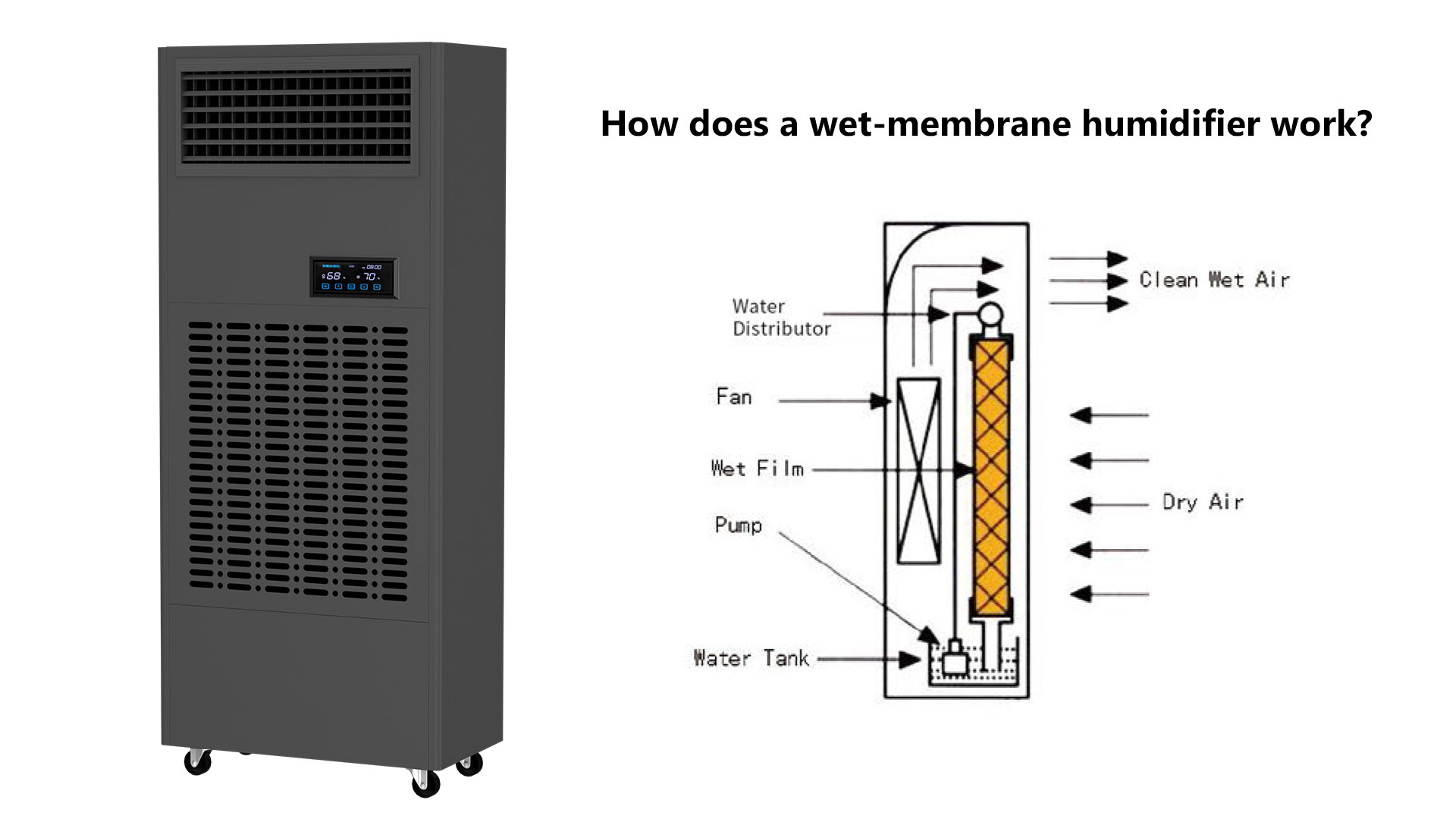


In numerous fields pursuing precise environmental control, the “cleanliness” of humidification technology has become
a critical metric. Compared to ultrasonic humidifiers that may produce “white powder” contamination or steam humidifiers
with relatively high energy consumption, wet membrane humidifiers offer a more natural and clean solution through their
unique isenthalpic humidification principle. This article delves into its operational principles, focusing on the core technologies
enabling “clean humidification.”
I. Core Principle: Isoenthalpic Humidification and Natural Evaporation
The operation of a wet-film humidifier fundamentally involves an isenthalpic humidification process—a heat and moisture
exchange between water and air. “Isoenthalpic” signifies that the total thermal energy (enthalpy) of the air remains
essentially unchanged during this process.
The specific workflow can be summarized in three steps:
Uniform Water Distribution: An internal pump conveys water from the reservoir to the distributor. Typically composed
of a series of pipes and nozzles, the distributor ensures water is evenly and gently dispersed like fine rain over the
large-area wet membrane material below, forming a thin, uniform water film.
Air Permeation: Dry air is forced through the moisture-saturated wet membrane by the fan.
Heat-Moisture Exchange: As dry air flows over the moist wet membrane, its vast contact surface enables water molecules
to rapidly absorb the air's sensible heat, evaporating into water vapor. This process increases the air's humidity (moisture content)
while simultaneously lowering its temperature due to heat absorption. With one increase and one decrease, the total enthalpy
of the air remains nearly constant, hence termed “isenthalpic humidification.”This method, relying purely onnatural water
evaporation for humidification, inherently possesses a “clean” nature.
II. Core Technology 1: Characteristics and Selection of Wet Membrane Materials
The wet membrane serves as the “lungs” of the humidifier, with its material properties directly determining humidification
efficiency, service life, and cleanliness. Current mainstream humidifier membrane materials primarily include the following categories:
Glass Fiber Humidifier Membrane:
Characteristics: Constructed from bonded glass fiber strands, it possesses an extremely high specific surface area and strong
capillary water absorption effect.
Advantages: High humidification efficiency, excellent water absorption, and strong inherent antibacterial and anti-mold properties.
Note: Requires specific water quality standards. Long-term use may lead to performance degradation due to scale buildup,
necessitating regular cleaning or replacement.
Aluminum Alloy Humidifier Membrane:
Characteristics: Manufactured from aluminum foil through specialized etching and forming processes to create hydrophilic
honeycomb channels.
Advantages: Exceptionally durable with high strength, non-bacterial growth, washable, and extremely long lifespan. Excellent
corrosion resistance allows adaptation to more complex water conditions.
Note: Initial cost is relatively high; humidification efficiency is closely tied to surface area design.
Plant Fiber Wet Membrane (e.g., CELdek):
Characteristics: Formed by bonding specially treated plant fiber paper, offering vast evaporation surface area and excellent
water absorption.
Advantages: Recognized as a highly efficient humidification material with outstanding humidification capacity. Its natural
fiber composition possesses inherent self-degradation properties, ensuring environmental friendliness.
Note: Relatively low material strength requires careful maintenance. Potential mold growth risk in specific environments
necessitates integration with a robust water management system.
Comparison Summary: Selecting a humidification membrane requires balancing efficiency, lifespan, maintenance costs,
and water quality conditions. Glass fiber offers high efficiency, aluminum alloy provides durability, while plant fiber excels
in efficiency and environmental friendliness.
III. Core Technology #2: Physical Evaporation for Clean Humidification Without White Residue
The essence of “clean humidification” lies in preventing any contaminants from entering the air. The key to wet membrane
humidifiers achieving this is:
Purely Physical Process: Humidification relies solely on the phase transition of water molecules from liquid to gas. Dissolved
minerals like calcium and magnesium cannot evaporate and are largely retained on the membrane surface or return to the
water tank with unevaporated water.
No white residue contamination: This stands in stark contrast to ultrasonic humidification. Ultrasonic humidifiers use
high-frequency vibrations to “break” water into micron-sized droplets directly dispersed into the air, causing all minerals
within the droplets to form a “white residue.” Wet membrane humidifiers, however, output pure water vapor, fundamentally
eliminating the white residue issue.
Water Management Integration: To achieve true cleanliness, modern wet-membrane humidifiers typically incorporate overflow
cleaning functionality. This periodically flushes the wet membrane with fresh water, washing away accumulated minerals and
trace organic matter. This prevents continuous concentration, scaling, or microbial growth on the membrane, ensuring sustained
clean humidification.
Summary
Wet-membrane humidifiers establish an efficient heat-moisture exchange platform through isenthalpic humidification—a physical
principle aligned with natural laws—combined with the precise collaboration of water distributors and high-performance membrane
materials. Their “clean humidification” characteristic stems not from post-filtration but from the fundamental principle of physical
evaporation, supported by a scientific water management system. Together, these ensure only pure water vapor enters the air.
For technicians, understanding the properties of different humidification membrane materials and their interplay with water quality
and maintenance is crucial for selecting the right equipment, optimizing its application, and fully leveraging the “clean” advantages
of humidification membrane humidifiers.
